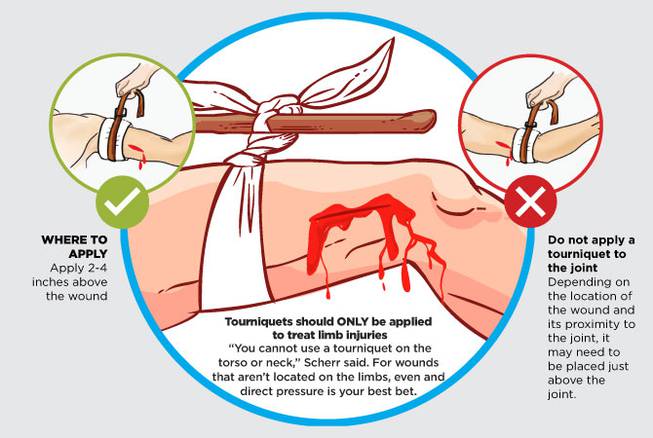
Monday, Dec. 4, 2017 | 2 a.m.
Meet the medical professional in this story
Scott A. Scherr, MD, FACEP, Chairman of Emergency Services at Sunrise Hospital and Medical Center
Creating and applying a tourniquet is a relatively simple technique that can help control blood loss following a traumatic injury. Used for wounds occurring on the limbs, the device compresses the area around the injury to limit blood flow until the wound can be treated and closed.
“Tourniquets can be used on many injuries that involve profuse bleeding and can be made with almost anything that uses circumferential pressure above the site of bleeding,” Dr. Scott Scherr said.
While tourniquets should only be used during serious medical emergencies, understanding how and why to apply a tourniquet to a wound can be a lifesaving measure.
When and when not to use a tourniquet
A tourniquet can be an effective tool to help stop bleeding, but when used incorrectly, it can cause serious complications and further injury. Because tourniquets severely restrict blood circulation to the area, improper application of the device can cause permanent nerve and tissue damage. In some cases, this can even lead to amputation of the limb.
Tourniquets should be used when the bleeding cannot be stopped by the use of direct pressure alone, or if direct pressure cannot be effectively applied for any reason.
Heavy and uncontrolled bleeding can cause death within minutes, so it’s necessary to act quickly when dealing with a traumatic wound. “Tourniquets should be applied immediately when there is evidence of rapid blood loss,” Scherr said. If the wound continues to bleed heavily under direct pressure, it may require a tourniquet.
Tourniquets should only be applied to treat limb injuries
“You cannot use a tourniquet on the torso or neck,” Scherr said. For wounds that aren’t located on the limbs, even and direct pressure is your best bet.
Do not apply a tourniquet to the joint
Depending on the location of the wound and its proximity to the joint, it may need to be placed just above the joint.
What to use
Many materials can be effective, and when improvising, clothing often is used. “Belts can be a good tourniquet,” Scherr said. “You can also tear a piece of clothing to approximately three inches wide.”
Shirt sleeves, pant legs, scarves and bandanas are all potential options. Whatever you use, be sure it’s wide and thick enough to prevent injury to the limb. It should be two to four inches wide to evenly distribute the pressure around the limb.
You can purchase tourniquet devices to keep in your first-aid kit.
What not to use
Scherr warns that thin material, such as wires or shoelaces, should not be used.
How to apply it
Wrap the material around the limb with an even circumference of pressure. The material should sit as flatly as possible against the skin to prevent neurovascular damage. If you have enough material, wrap it a few times to create padding.
When using fabric, knot a stick or other rigid object, like a pen, on the outside layer of the tourniquet to create a torsion device. Twist the stick to tighten the hold. Continue to twist until tight enough, and knot it again to keep it in place.
If possible, it’s important to keep direct pressure on the wound even after applying a tourniquet. Then immobilize the injured area and call 911 immediately, Scherr said.
Can you apply it on yourself?
Yes, if that’s your only option. “If the injury is on your arm, use your mouth/teeth to help secure the material,” Scherr said.
How tight should it be?
“Tight enough to stop the bright red bleeding. You may see dark red blood oozing, which is OK,” Scherr said. It should feel uncomfortably tight, but not tight enough to cause any paramount pain.
How long can you leave it on?
A tourniquet should only be used in an emergency until you’re able to receive immediate medical attention. “It can be applied for approximately two hours before neurovascular injury occurs,” Scherr said.
Do not remove a tourniquet yourself. A medical professional should do it for you.
